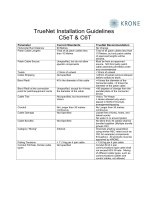Java pocket guide instant help for java programmers
Bạn đang xem bản rút gọn của tài liệu. Xem và tải ngay bản đầy đủ của tài liệu tại đây (2.3 MB, 492 trang )
Java Pocket Guide
FOURTH EDITION
Robert Liguori and Patricia Liguori
Java Pocket Guide
by Robert Liguori and Patricia Liguori
Copyright ©2017 Gliesian, LLC. All rights reserved.
Printed in the United States of America.
Published by O’Reilly Media, Inc., 1005 Gravenstein Highway North,
Sebastopol, CA 95472.
O’Reilly books may be purchased for educational, business, or sales
promotional use. Online editions are also available for most titles
( For more information, contact our
corporate/institutional sales department: 800-998-9938 or
Editor: Brian Foster
Production Editor: Justin Billing
Copyeditor: Amanda Kersey
Proofreader: Marta Justak
Indexer: Ellen Troutman-Zaig
Interior Designer: David Futato
Cover Designer: Karen Montgomery
Illustrator: Rebecca Demarest
September 2017: Fourth Edition
Revision History for the Fourth Edition
2017-08-25: First Release
See for release
details.
The O’Reilly logo is a registered trademark of O’Reilly Media, Inc. Java
Pocket Guide, the cover image, and related trade dress are trademarks of
O’Reilly Media, Inc.
While the publisher and the authors have used good faith efforts to ensure
that the information and instructions contained in this work are accurate, the
publisher and the authors disclaim all responsibility for errors or omissions,
including without limitation responsibility for damages resulting from the use
of or reliance on this work. Use of the information and instructions contained
in this work is at your own risk. If any code samples or other technology this
work contains or describes is subject to open source licenses or the
intellectual property rights of others, it is your responsibility to ensure that
your use thereof complies with such licenses and/or rights.
978-1-491-93869-0
[M]
This book is dedicated to our beautiful daughter, Ashleigh.
Preface
Designed to be your companion, this Pocket Guide provides a quick
reference to the standard features of the Java programming language and its
platform.
This Pocket Guide provides you with the information you will need while
developing or debugging your Java programs, including helpful programming
examples, tables, figures, and lists.
Java coverage in this book is representative through Java SE 9 incorporating
a subset of the 80+ JDK Enhancement Proposals (JEPs) slated for the release.
This Java coverage includes improvements to the generage language as well
as coverage of the new Java Shell and the new Java Module System. This
book supercedes the three previous versions: Java Pocket Guide, Java 7
Pocket Guide, and Java 8 Pocket Guide.
For uniformity and enhanced interest, the majority of the code examples in
this fourth edition of the Java Pocket Guide have been updated from code
segments of the Gliesians Web Application. At the time of this writing, the
primary focus of the Gliesians Web Application is to provide free utilities
relative to genealogy and small unmanned aerial systems.
The material in this book also provides support in preparing for the Oracle
Certified Programmer exams. If you are considering pursuing one of the Java
certifications, you may also wish to acquire the OCA Java SE 8 Programmer
I Study Guide (Exam 1Z0-808) by Edward Finegan and Robert Liguori
(McGraw-Hill Osborne Media, 2015).
Book Structure
This book is broken into three parts: Part I details the Java programming
language as derived from the Java Language Specification (JLS) and JEPs.
Part II details Java platform components and related topics. Part III is the
appendixes covering supporting technologies.
Conventions Used in This Book
The following typographical conventions are used in this book:
Italic
Indicates new terms, URLs, email addresses, filenames, and file
extensions.
Constant width
Used for program listings, as well as within paragraphs to refer to
program elements such as variable or function names, databases, data
types, environment variables, statements, and keywords.
Constant width bold
Shows commands or other text that should be typed literally by the user.
Constant width italic
Shows text that should be replaced with user-supplied values or by
values determined by context.
TIP
This element signifies a tip, suggestion, or general note.
WARNING
This element indicates a warning or caution.
O’Reilly Safari
NOTE
Safari (formerly Safari Books Online) is a membership-based training and
reference platform for enterprise, government, educators, and individuals.
Members have access to thousands of books, training videos, Learning Paths,
interactive tutorials, and curated playlists from over 250 publishers, including
O’Reilly Media, Harvard Business Review, Prentice Hall Professional,
Addison-Wesley Professional, Microsoft Press, Sams, Que, Peachpit Press,
Adobe, Focal Press, Cisco Press, John Wiley & Sons, Syngress, Morgan
Kaufmann, IBM Redbooks, Packt, Adobe Press, FT Press, Apress, Manning,
New Riders, McGraw-Hill, Jones & Bartlett, and Course Technology, among
others.
For more information, please visit />
How to Contact Us
Please address comments and questions concerning this book to the
publisher:
O’Reilly Media, Inc.
1005 Gravenstein Highway North
Sebastopol, CA 95472
800-998-9938 (in the United States or Canada)
707-829-0515 (international or local)
707-829-0104 (fax)
We have a web page for this book, where we list errata, examples, and any
additional information. You can access this page at />To comment or ask technical questions about this book, send email to
For more information about our books, courses, conferences, and news, see
our website at .
Find us on Facebook: />Follow us on Twitter: />Watch us on YouTube: />
Acknowledgments
We extend a special thank you to all the folks at O’Reilly. Appreciation of
support also goes out to Greg Grockenberger and Ryan Cuprak, who wrote
for the JShell and Java Module System chapters, respectively. Ryan also
performed the technical review of the book, which we appreciate.
We would also like to thank again all of those who participated with the
original Java Pocket Guide, the Java 7 Pocket Guide, and the Java 8 Pocket
Guide.
Additional appreciation to people not related to this book project: Don
Anderson, David Chong, Keith Cianfrani, Jay Clark, Steve Cullen, Ed
DiCampli, Phil Greco, Scott Houck, Cliff Johnson, Juan Keller, Fran Kelly,
Mike Krauss, Mike Lazlo, Phil Maloney, Lana Manovych, Matt Mariani,
Chris Martino, Roe Morande, Sohrob Mottaghi, Brendan Nugent, Keith
Smaniotto, Tom Tessitore, Lacey Thompson, Tyler Travis, Justin Trulear,
and Jack Wombough.
Part I. Language
Chapter 1. Naming Conventions
Naming conventions are used to make Java programs more readable. It is
important to use meaningful and unambiguous names comprised of Java
letters. The following examples are from various Java sources.
Acronyms
When using acronyms in names, only the first letter of the acronym should be
uppercase and only when uppercase is appropriate:
// e.g., DNA is represented as Dna
public class GliesianDnaProvider {...}
// e.g., Most Recent Common Ancestor (MRCA) is Mrca
public class MrcaCalculator {...}
Annotation Names
Annotation names have been presented several ways in the Java SE API for
predefined annotation types, [adjective|verb][noun]:
@Documented
@Retention(RetentionPolicy.RUNTIME)
@Target(ElementType.TYPE)
public @interface FunctionalInterface {}
Class Names
Class names should be nouns, as they represent “things” or “objects.” They
should be mixed case (camel case) with only the first letter of each word
capitalized, as in the following:
public class AirDensityCalculator {...}
Constant Names
Constant names should be all uppercase letters, and multiple words should be
separated by underscores:
private static final double KELVIN = 273.16;
private static final double DRY_AIR_GAS_CONSTANT = 287.058;
private static final double HUMID_AIR_GAS_CONSTANT = 461.4964;
Enumeration Names
Enumeration names should follow the conventions of class names. The
enumeration set of objects (choices) should be all uppercase letters:
public enum MeasurementSystem {
METRIC, UNITED_STATES_CUSTOMARY, IMPERIAL
}
public enum Study {
ALL, NON_ENDOGAMOUS, SEMI_ENDOGAMOUS, ENDOGAMOUS
}
public enum RelationshipMatchCategory {
IMMEDIATE, CLOSE, DISTANT, SPECULATIVE
}
Generic Type Parameter Names
Generic type parameter names should be uppercase single letters. The letter T
for type is typically recommended.
The Collections Framework makes extensive use of generics. E is used for
collection elements, S is used for service loaders, and K and V are used for
map keys and values:
public interface Map <K,V> {
V put(K key, V value);
}
Instance and Static Variable Names
Instance and static variable names should be nouns and should follow the
same capitalization convention as method names:
private String prediction;
Interface Names
Interface names should be adjectives. They should end with “able” or “ible”
whenever the interface provides a capability; otherwise, they should be
nouns. Interface names follow the same capitalization convention as class
names:
public interface Relatable {...}
public interface SystemPanel {...}
Method Names
Method names should contain a verb, as they are used to make an object take
action. They should be mixed case, beginning with a lowercase letter, and the
first letter of each subsequent word should be capitalized. Adjectives and
nouns may be included in method names:
public
public
public
public
void clear() {...} // verb
void toString() // preposition and noun
double getDryAirDensity() {...} // verb, adjective and noun
double getHumidAirDensity() {...} // verb, adjective and noun
Package Names
Package names should be unique and consist of lowercase letters.
Underscores may be used if necessary:
// Gliesian.com (company), JAirDensity (software)
package com.gliesian.jairdensity;
// Gliesian.com (company), FOREX Calculator (software), Utilties
package com.gliesian.forex_calculator.utils;
Publicly available packages should be the reversed internet domain name of
the organization, beginning with a single-word top-level domain name (e.g.,
com, net, org, or edu), followed by the name of the organization and the
project or division. (Internal packages are typically named according to the
project.)
Package names that begin with java and javax are restricted and can be used
only to provide conforming implementations to the Java class libraries.
Module Names
Module names should be the reversed internet domain name with the same
guidelines as package names:
module com.gliesian.utils {
}
Parameter and Local Variable Names
Parameter and local variable names should be descriptive lowercase single
words, acronyms, or abbreviations. If multiple words are necessary, they
should follow the same capitalization convention as method names:
public void printPredictions (ArrayList predictions) {
int counter = 1;
for (String prediction : predictions) {
System.out.println("Predictions #" + counter++ + ": " + prediction);
}
}
Temporary variable names may be single letters such as i, j, k, m, and n for
integers and c, d, and e for characters. Temporary and looping variables may
be one-character names as shown in Table 1-1.
Table 1-1. Temporary
and looping variables
One-character name Type
b
Byte
c
Character
d
Double
e
Exception
f
Float
i, j, or k
Integer
l
Long
o
Object
s
String









